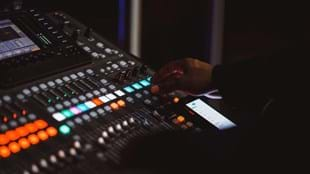SARAH SHORTT: Let’s start at the beginning. How does the music get from the Program Director's head to the Release?
JOSH: Around 12 weeks out from filming, the Program Directors will provide us with their wish list of songs.
KENDALL: There are 12 songs in BODYPUMP™ but initially we might be looking at 40 songs in total. Josh and I go through the list and find out which label all those songs belong to.
JOSH: Sometimes the label can be tricky to find. For example, there might be one label that controls the master, but we also need to get permission from the featured artist.
KENDALL: Or there might be one label that controls the song in North America and then another label that controls the song for the rest of the world, so we have to talk to both of them. We have to get worldwide rights because our Instructors are from many different countries – we need them to be able to teach to the same music in Russia or Sweden or Brazil.
JOSH: In that initial batch there might be a few songs that are immediately identified as unable to license and that could be because they’re a banned artist – there are a few that we just can’t request – or there might be another reason, like we already know that the track contains an uncleared sample and we’re not going to get approval from the label.
KENDALL: It might be what we call a “bootleg” remix – something that you’ll find on YouTube or SoundCloud and it’s a free download but you won’t actually be able to find that anywhere official, because it’s not an “official song”. And if it’s not an “official song” then you can’t license it, it’s not legal.
JOSH: And then in a couple of rare cases there are artists who aren’t willing or are unable to grant us the rights that we need to distribute the release. As we distribute through the Releases App, we’ve got to have streaming, we have to have an offline mode or a download mode…
When you are licensing music there are always two rights to a track – so there’s the master recording which is what you hear on the radio or Spotify…
KENDALL: That’s the artist actually singing the song – so P!nk’s voice and the music – that’s the master or sound recording.
JOSH: Someone at Sony paid for P!nk to come into a recording studio and make that music, so they own that master recording. Underneath that is the underlying composition, and that’s the lyrics, the sheet music, melody and everything goes into writing the song. That is the publishing side.
So we also have to secure the rights to that. We have to clear both the publishing and master.
KENDALL: Josh looks after the major labels.
JOSH: We have relationships with Sony, Warner and Universal.
We request tracks in batches, labels give us feedback on those batches – some tracks are a no, some a yes, some may have side artists that need to be cleared. We feed that back to the Program Directors and – depending on what songs they get or don’t get – they add more tracks. We work through a three batch cycle to determine what songs we will have permission to use.
KENDALL: And then we have a few independent labels that we work with in a similar way to the majors, in that we send them two or three emails a quarter with a list of songs and they’ll just let me know if they can clear them, they’ll be considered done and we’ll just move on.
We touched about 295 independent labels last year. Some of those might have a contact that is able to rep several labels for you, and that is awesome when that happens because you know you can go to one person for quite a few tracks, but that isn’t always the case.
A lot of these labels are anywhere from massive independent labels like BMG, who represent people like Fat Boy Slim, right through to literally “I’m the person making my music in my bedroom and I’m repping myself” – and that’s the person that I’m emailing. So that’s quite cool when you get to deal with the artist because they’re always quite excited that their music’s being heard and they’re always happy for some money. My job is to reach out to all those labels individually and often I’m reaching out to people I’ve never spoken to before because new labels, new music… due to the scope of the music that’s available in the age of streaming.
Sometimes I have to explain from scratch who we are and what this weird thing called group fitness is, and how we choreograph it to music and we need these rights and these rights… what we actually need is quite complicated.
I have to negotiate every single track with these labels and for the most part it goes really well and they’re pretty excited to work with us. Some of them are a little bit more difficult and some of them are SO independent that you literally just cannot get hold of a single person employed by what you would assume is a business. We do our best!
Sometimes it takes months and months to work through a contract for one song, it can take up to nine months. Indie labels generally have transient work forces so you might line up a whole lot of stuff with someone, have everything agreed, everything is running really smoothly… then you follow up with an email a week later and you get an out-of-company email saying I no longer work here, I’m travelling around Europe in my van. Then you’re starting from scratch again. In most cases you work through it.
We had a K-pop song for SH’BAM™ – the label is now distributed by Universal but when it was first blowing up on the Western charts, I was trying to get hold of this company in Korea and their email would filter me out because they’re a huge company and get billions of emails from all these K-pop superfans. I realised I would have to call them, so first emailed everybody in the Les Mills office to see if anyone spoke Korean, then called the office in Korea – feeding it through google translate via speaker phone to get what they were saying in English and trying to figure out which button to push based on where I needed to get to. I tried calling four times before I finally figured out they were saying it was out of office hours (lol) so we’re really glad that they ended up being distributed by Universal because there was no way I could contact them before that. We’ll never give up – I will call Korea if I have to!
What’s the difference between a cover and an LMO (Les Mills Original)?
KENDALL: An LMO is a piece of music or track that we commission, that we control all the rights to – we own the sound recording and the publishing – meaning we can use it in our marketing materials, in our social media… we own all the rights to do whatever we want with that piece of music. We work with music producers to create the track.
JOSH: Whereas with a cover, we create a new sound recording of an existing song – a customised version. Les Mills owns the sound recording but we still need to secure the rights and pay the royalties to the people who wrote the song (the publishing side).
Why would you choose to use an LMO?
JOSH: Sometimes they choose us. We don’t always commission LMOs we have some artists that come to us with music and if there is a program or a project that aligns then we may make arrangements to purchase the track and then it becomes an LMO.
In other cases tracks that have been commissioned for marketing campaigns are heard by Program Directors and they have asked if it’s possible to get a longer version made as they like the sound and want to use it in a class.
KENDALL: Sometimes we choose an LMO because of the structure of the workout. The Program Director might want a track specifically for a Tabata that they can put countdowns into, or they want a very specific sort of dynamic and it’s easier sometimes to get something made for that move.
If we have a track across lots of programs, do you just pay once?
KENDALL: We pay for every single use so we pay to use a song in CXWORX™ and if we also want to use it in BODYPUMP we pay again for that program.
JOSH: We do have to pay twice and it’s actually something that we dread – we’re going back to a label saying to them, hey you know how we used that track? We want to use it again and they’re like, kerching! We’re immediately struggling to get it at the same price we purchased it at originally and you don’t get discounts for bulk in music… if anything they go, OK, cool, we can charge you a little bit more ‘cause you’re super keen!
Do you ever get approval for one program and not for another?
KENDALL: There are a few major label artists that have restrictions. For example, with Knife Party we are only allowed to use one track, one program, one quarter.
Some labels have a limit on how many tracks are in the compilation – so we can only put a track in the release if there are, say, 13 or fewer songs in that whole class… and if there are more than that, then we can’t have a song from that label for that compilation.
JOSH: It’s very label-dependent and we keep a comprehensive list of limitations so we can let the Program Directors know straight away if they can or can’t use that song or – if they’re going to use it – what they can and can’t do with it.
KENDALL: There was a song that was in BODYPUMP – Company by Baauer – that song had been requested for about three rounds and we couldn’t use it because it had an uncleared sample. Behind the scenes the label had just been working at it and then came back and said, we’ve cleared it now, you can use it… that song took probably a year to actually get into BODYPUMP.
Sometimes the songs don’t stay fresh, so the Program Director may no longer want it by the time we’re able to use it. We had one a year ago with Tiësto in BODYJAM and everyone wanted to use it and we scrambled right up to filming day… and in the end they said sorry, we just can’t get this through.
Three weeks later they were emailing us telling us, hey that track’s available, it’s good to go now, but filming had been and gone. Gandalf had found something else.
JOSH: It’s pretty frustrating for the Program Directors because there’s no logic to it, no pattern.
KENDALL: It’s hard when you’ve got your heart set on a track. Sometimes it’s down to the people you’re dealing with at the label, what kind of person they are.
Which programs use covers?
JOSH: I’m struggling to think of a program that hasn’t used a cover, whether it is one of ours or one another artist has done and we have licensed it.
The energy of some programs, like BODYATTACK™ for example, call for a faster BPM. Lisa [Osborne] may have a track she really wants to use but it’s not quite fast enough, so she will opt to use a cover where she can work with our producers to get the right BPM profile to fit the choreography.
Sourcing music is hard! The Program Directors do a great job. Some would rather not use covers as they simply don’t work for their programs, while others might need a particular track as it’s part of a block and if one track is unavailable then others won’t work as well without it... so then a cover is the best option.
Since we went digital, why aren’t our releases cheaper?
JOSH: There’s still a lot of costs associated with digital distribution. Building and maintaining an app for an audience of over 100, 000 people is a considerable investment.
KENDALL: There’s a cost associated with all the data that’s streamed through the app so any time someone watches the release – we pay for it. Any time someone listens to it, we pay for it. We pay to have the content there so they can access it, we pay for the features in the app. Mix and Match is a prime example and anybody that’s worked in web or app development will know that software development is costly.
It’s also the full release that you pay for – the music is part of it but it there’s also the education videos associated with it, the choreography notes and video production and now that we’ve got the app we can offer additional value that you would never have got with the CD and DVD. We’d never have been able to give you free meditations or the education sessions that are tailored for you, and we wouldn’t have been able to give you these sessions immediately either.
There’s a whole lot of functionality that the app offers that we never had before. In the past, Instructors used to have to wait for us to send the physical kits to the markets. Now, there’s a lot of work behind the scenes, then we push a button and it’s there.
What keeps you up at night?
JOSH: If Chance the Rapper is an Instructor, could he please get in touch with us? I’d really like to hear from you, feel free to collect call …
KENDALL: It’s frustrating when you get that initial contact or initial approval but then you get radio silence and all of a sudden you’re going OK, why don’t you like me, what happened? Sometimes you get approval and it’s full steam ahead and then suddenly they say, oh no we don’t own that part of the song – that makes my stomach drop. We’ve always been able to salvage it thus far but that’s the kind of thing that keeps me up at night. Just answer my emails, Chance the Rapper. Answer me! I just want to license “All Night”.








